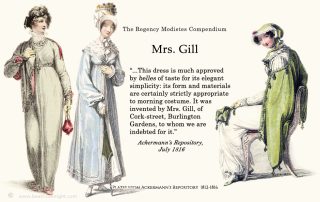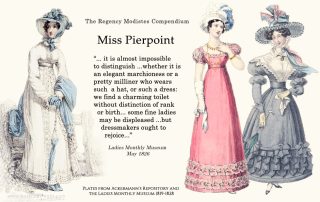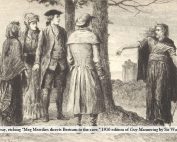Mrs. Gill
Mrs. Gill was one of the leading modistes of the Regency, and pioneered the design of white wedding dresses at a time when few women of fashion wore them. She was also deeply involved in charity work for the Asylum of the Deaf and Dumb Children of the Poor, along with her husband David. Mrs. Eliza Gill 1781-1856 1807-1820: 1 Cork St., Burlington Gardens. Unlike many of her counterparts, Mrs. Gill did not take out newspaper advertisements notifying "The Nobility and Gentry" of her latest gowns. She built her name as a modiste largely through [...]
Miss Macdonald
Fashion has always been a copy-cat industry. One of the best known Regency modistes, Miss Macdonald (later Mrs. Smith) was ahead of the curve, creating designs and trim techniques that "inspired" many of her competitors, and promoting the white wedding dress as a style in its own lane. Miss Euphemia Macdonald (1793-1857) 1810-18: 84 Wells St. 1818-20: 50 South Molton St. Hanover Square 1820-21: 29 Great Russell St., Bedford Square /15 Old Burlington St. Miss Macdonald was a prominent Regency milliner/dressmaker who left a lasting legacy in her approach to bridal fashion. At a time [...]
Miss Pierpoint
The self-declared "inventor of the Corset à la Greque," Miss Pierpoint was the busiest marketer of all the Regency modistes, with over 230 of her dresses appearing in fashion plates across multiple publications from mid-1819 until she went out of business ten years later. Miss Mary Maria Pierpoint (1787-1835) 1819-21: 9 Henrietta St. Covent Garden 1821-29: 12 Edward St. Portman Square Miss Pierpoint was perhaps the most "modern" modiste of the Regency era. She understood how to boost her brand through name recognition, targeting both the élégantes of the ton and the prosperous middle-class women who wanted to [...]
Other Interesting Posts
Outsiders Within – Romani in the Regency
By the time 'Gypsies' appeared on the pages of Jane Austen, Sir Walter Scott and Maria Edgeworth, Romani people had been in England for centuries. Sidebar: Believing the copper-skinned migrants to hail from Egypt, the Europeans had coined the term "Gypsies" for these migrants. Some consider [...]




